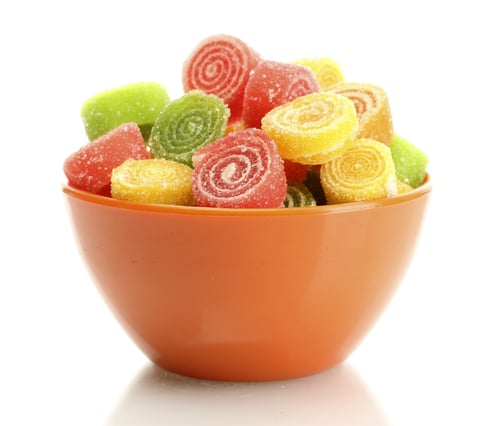
Cut Back on Sugar: You’ll Be More Focused and Motivated
You might think your brain would function best if you eat a diet high in sugar. It’s true that the brain quickly sucks up glucose to use as fuel. The problem is a high sugar diet triggers the release of greater amounts of insulin. This leads to a more rapid drop in blood sugar, the so-called “sugar crash” that leaves you feeling tired, unmotivated and unfocused.
To maintain your energy level without those crashes, it’s best to eat high-fiber carbohydrates along with a source of protein to slow down absorption and reduce insulin release. Eating small meals more frequently helps to prevent a drop in energy level and focus too. Will you accomplish more if you eat a low-sugar diet? You’ll certainly have more energy and motivation to get things done.
Cut Back on Sugar: You’ll Get More Vitamins and Nutrients
Sugar is a source of empty calories. That’s because it has no vitamins, minerals, and nutrients. When you remove it from your diet, you can “fill in” with more nutrient-dense alternatives that are better for your health. By simply eliminating most sugar from your diet, you’ll improve the quality of what you eat.
Cut Back on Sugar: You’ll Have Fewer Cravings
How are most people doing when it comes to controlling sugar in their diet? Not very well. The American Heart Association recommends that women limit sugar in their diet to 6 teaspoons a day or less. How many is the average American getting? A whopping 22 teaspoons! Most people aren’t dipping a spoon into the sugar bowl 22 times a day. They’re getting it from packaged foods. Many are completely unaware of how much sugar they’re getting from packaged foods because they don’t read the label.
How does sugar contribute to cravings? It sends blood sugar and insulin levels on a roller coaster ride. When your blood sugar drops quickly after a high-sugar snack, you crave more sugar. It’s a vicious cycle and one you’ll want to break if you’re trying to control your weight – and your health.
Cut Back on Sugar: Younger Looking Skin?
Can sugar prematurely age your skin? Research shows that sugars bind to collagen fibers, the protein in the dermal layer of your skin that keeps it firm and youthful, and form crosslinks. These crosslinks destroy the integrity of collagen so it can’t do its job of supporting your skin and keeping wrinkles in check.
Fructose seems to be the form of sugar most adept at doing this based on animal studies. This crosslinking phenomenon is an example of glycation, a process thought to damage not only collagen but other proteins in your body as well. That’s why a high-sugar diet has been linked with aging. A high-sugar diet also decreases skin’s elasticity or the ability to “bounce back.” You want your skin to be resilient, don’t you?
Cut Back on Sugar: It May Reduce Your Risk for Heart Disease
A diet high in sugar elevates triglycerides, a type of fat that circulates in the blood. High triglycerides are linked with a greater risk for heart disease. Diets high in sugar also lower HDL-cholesterol, the kind that’s linked with a lower risk for heart disease. Plus, diets high in sugar are pro-inflammatory. That’s not good for your heart or your blood vessels.
Cut Back on Sugar: Reduce Your Dental Bills
You already know that diets high in sugar are linked with tooth decay. Reducing sugar in your diet could reduce the number of times your dentist has to turn on the drill when you drop by for a check-up. Less discomfort and a lower dental bill? That sounds like a winning combination.
The Bottom Line?
For reducing the amount of sugar in your diet, the take-home message is read the label. Don’t assume because something doesn’t taste sweet that it’s not high in sugar. Even better – stick with unprocessed foods. Just as importantly, watch what you’re sipping. Many people get a substantial amount of sugar from beverages like soft drinks and fruit juice. If you like your beverages flavored, try iced herbal tea instead of fruit juice. When you’re sipping and eating your sweets, the sugar grams add up quickly.
Keep a record of how much sugar you’re consuming each day. Don’t forget to include condiments and beverages. Prepare to be surprised – and to make changes. Don’t worry about it. It’s worth it. Once you’ve reduced the amount of sugar in your diet you’ll crave it less. In fact, items that once tasted good to you will taste too sweet.
Don’t forget that rapidly absorbed carbs from white foods such as white rice, white flour and pasta have the same disadvantages as sugar since they’re rapidly absorbed and raise your blood sugar level quickly. Think high-fiber and you’ll usually make the right choice.
References:
Science Daily. “Fructose Consumption May Accelerate Aging — Skin’s Elasticity And Softness May Be Affected”
Heart Wire. “Added sugars” in diet linked to higher triglycerides, lower HDL-C in NHANES data”
Circulation. 2002; 106: 523-527.
Related Articles By Cathe:
More Evidence That Cutting Back on Sugar Helps With Weight Control
5 Surprising Things That Happen When You Cut Back on Sugar
5 Things That Happen When You Stop Sugar Cravings
Juicing Your Way to Weight Loss: 5 Reasons It’s Not a Good Idea

